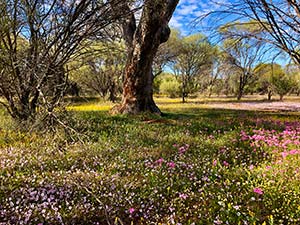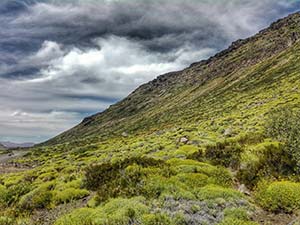
Scottish American naturalist John Muir once said that “between every two pines, there is a doorway to a new world.”
The University of Wyoming’s Biodiversity Institute is looking to expand that doorway beyond just the pines -- to other trees, wildflowers, cacti and other vegetation worldwide with its Global Vegetation Project.
The mission of the Global Vegetation Project is to inspire and empower people of all ages to learn about the diversity of vegetation on Earth and to provide educators with a resource for teaching online. The goal is to bring the field into the classroom in a way that was previously impossible, enabling visual and interactive experiences that link vegetation and climate at the global scale.
“Our focus is global in scope. We are getting lots of photos from South America, which is exciting,” says Daniel Laughlin, project director for the Global Vegetation Project. “But, naturally, many of our first photos are from North America, and we have plans to make sure that the Rocky Mountain and High Plains ecoregions are well represented in the database for use in Wyoming schools.”
“It's a community science project allowing users to access, and add to, a database of vegetation photographs that can be explored interactively through an online mapped interface,” says Bryce Tugwell, web content developer and digital storyteller for the Biodiversity Institute.
Anyone with an internet connection will be able to challenge themselves to tackle a variety of learning outcomes.
These learning outcomes are:
-- Determining differences and similarities among vegetation types across the globe.
-- Understanding how climate shapes vegetation.
-- Hypothesizing how climate change might affect the distribution of vegetation types in the future.
“We do encourage people to share their unique vegetation with the project,” Laughlin says. “We want it to be a one-stop shop for open access vegetation photos, and to celebrate the immense diversity of vegetation worldwide.”
When a photo is submitted, the project team conducts quality control to make sure the location of the photo is correct, and that the photo is appropriate. Then, the team takes the location of the photo and spatially joins it to other spatial data layers to determine biome, ecoregion, province/country, mean annual temperature, mean annual precipitation, and temperature and precipitation averages by month to create Walter-Lieth climate diagrams.
“We plan to develop lesson plans to teach students about the relationship between vegetation types and these climate diagrams,” Laughlin says.
The project was inspired both by the increased need for online field ecology teaching resources as well as the lack of a single e-repository with information on the diversity of vegetation types across the globe, according to the project website.
The project is similar to iNaturalist, but with a focus on communities of plant vegetation rather than individual species. With the help of user-submitted photos, location information and vegetation information, the Global Vegetation Project will create an interactive map where “travelers” can virtually navigate to points to explore vegetation types, Laughlin says.
Travelers can explore using a global map or by using a Whittaker biome diagram, which illustrates how vegetation types relate to temperature and precipitation. Alternatively, vegetation can be viewed by filtering for specific regions, biomes or presence of individual species. The Whittaker biome diagram is a fundamental starting point for understanding the vegetation of the world.
“While this will eventually develop into a community science initiative, we do require the contributors to identify the vegetation type and a few dominant species in the photo,” Laughlin explains. “So, some base-level knowledge is required at present.”

While still under discussion, the group has considered relaxing this assumption, with the possibility of allowing anyone to submit photos without having to know species and vegetation types.
To create awareness and interest in the project, Laughlin says social media accounts have been created on Facebook, Instagram and Twitter. Sienna Wessel, a master’s student from Champaign, Ill., majoring in botany and the project’s science communications manager, has created two videos that will be posted on the project’s website and distributed via social media. Additionally, the group plans to send targeted emails to vegetation scientists around the world to invite them to contribute. Laughlin says he has sent messages to email listservs such as ECOLOG.
With a National Science Foundation grant Laughlin has secured, he says it will be used to hire an RET (Research Experience for Teachers) position next summer.
“This teacher will work with us to learn about vegetation diversity across climatic gradients; develop curricula for grade school- and high school-level students; and travel across the region and take photos for the project,” Laughlin says. “Our long-term goal is to develop teaching lessons for a variety of grade levels, and the RET will be an important component to that.”
Laughlin relies on a small group of collaborators to keep the project moving forward. Shannon Albeke, a senior research scientist with the Wyoming Geographic Information Science Center (WyGISC) was instrumental in developing the database and web map services for the application. The Advanced Research Computing Center on campus has provided support for hosting the database and the server. Jesse Fleri, a first-year Ph.D. student from Lake Forest, Calif., in the Program in Ecology and botany, is the R Shiny app developer. Tugwell enabled the web interface in the UW Biodiversity Institute as part of its facilitation of externally funded broader impacts of research.
To submit a photo(s), fill out the form at www.gveg.wyobiodiversity.org/index.php/entry-submission.
For more information about the Global Vegetation Project, go to the website at www.gveg.wyobiodiversity.org; Facebook at www.facebook.com/GlobalVegProj/; Twitter at www.twitter.com/GlobalVegProj; and Instagram at www.instagram.com/globalvegproj/.
For videos about the Global Vegetation Project, go to https://drive.google.com/file/d/1asQVTN1PanqFOBK7PuPMP31TBp1LCH7_/view and https://drive.google.com/file/d/1_5pbPtcrenWaHVGY812LO5idPuEDGkLG/view.
About the Biodiversity Institute
The mission of the Biodiversity Institute is to foster the understanding, appreciation and conservation of biological diversity through innovative research, education and outreach; and by engaging a broad audience in the scientific process.

